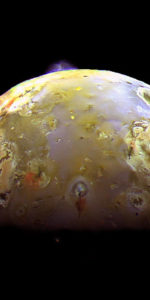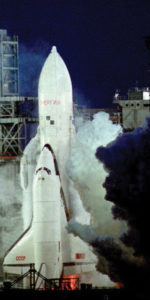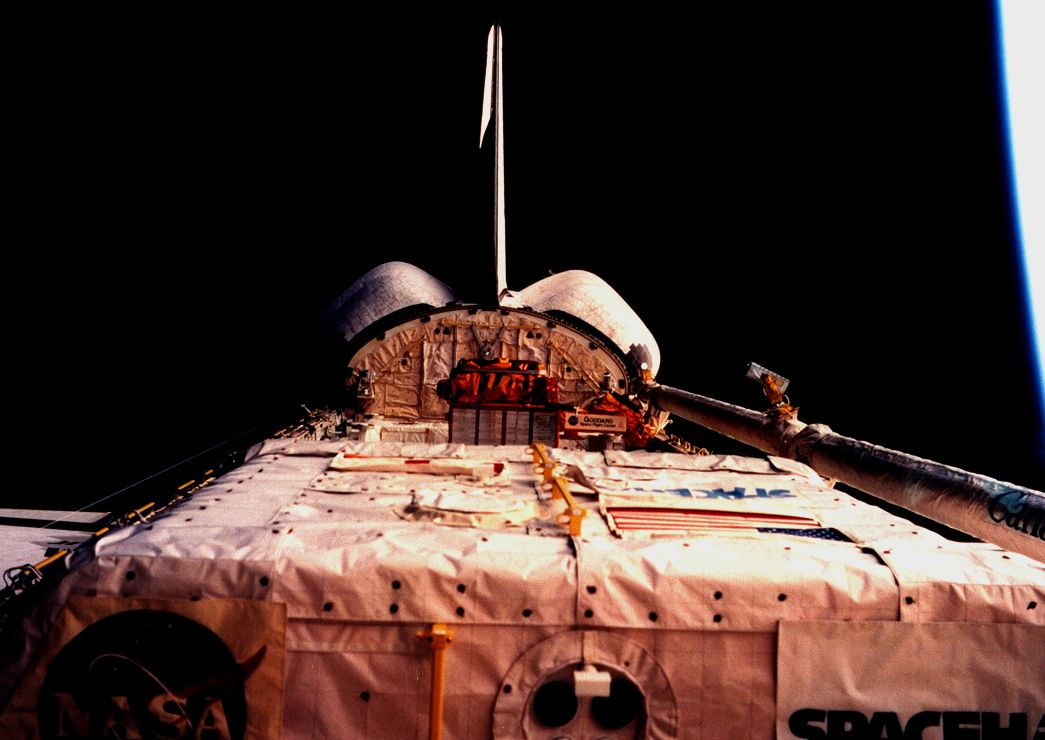
Twenty years ago this week, six men orbited Earth aboard Shuttle Endeavour on one of the most complex research flights ever conducted in the program’s 30-year history. With such a large number of payloads aboard, it was imperative for the STS-77 crew—Commander John Casper, Pilot Curt Brown, and Mission Specialists Andy Thomas, Dan Bursch, Mario Runco, and Canada’s Marc Garneau—to begin activating as many experiments as possible on the first day of their 10-day flight. As described in yesterday’s AmericaSpace history article, STS-77 was tasked with a multitude of experiments in the commercial Spacehab-4 laboratory and the deployment and retrieval of as many as four free-flying satellite payloads. Launch was originally targeted for 16 May 1996, but was pushed back to the 19th, since the earlier date was not available to NASA on the Eastern Range schedule. The crew had been training for the mission for almost a year, having been assigned in June 1995, and took their seats aboard Endeavour for an early-morning liftoff at 6:30 a.m. EDT.
“Really an amazing and wonderful experience,” was the opinion of first-time flier Andy Thomas, an Australian-born U.S. astronaut, who was seated on Endeavour’s flight deck for ascent. “I could look out the overhead windows with a wrist-mirror. I could see the flame in the flame trench, prior to liftoff; I could see the flash of the [Solid Rocket Booster] ignition; and then feel the lurch as we were accelerated upwards.”
Following this smooth ascent into the steadily retreating darkness of a Florida dawn, the six men reached orbit, doffed their pressure suits, and set to work. In spite of a problem with a cooling device for one of the orbiter’s Hydraulic Power Units (HPUs), Thomas and Garneau opened the hatch into the Spacehab module, floated inside, and began powering up experiments. Later in the day, Thomas also checked out the shuttle’s Canadian-built Remote Manipulator System (RMS) mechanical arm, ahead of the deployment of their SPARTAN-207 satellite payload. As the only first-time flier on STS-77, Thomas served as the payload commander, with overall responsibility of all of the mission’s research goals.
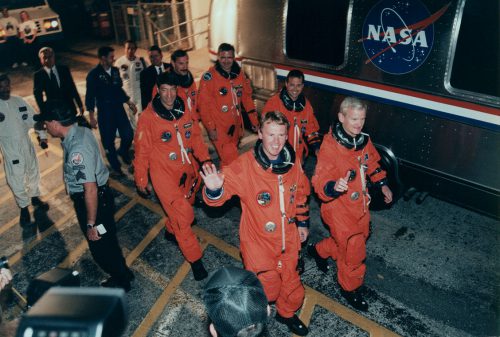
In Endeavour’s middeck, the Immune-3 experiment tested the ability of insulin-like growth factor to prevent or reduce the detrimental effects of microgravity exposure on the immune and skeletal systems of rats, whilst three investigations sought to crystallize various protein crystals with objectives to address a range of diseases and the Gas Permeable Polymer Membrane (GPPM) pioneered the development of enhanced polymers for manufacturing rigid gas-permeable contact lenses. The National Institutes of Health (NIH) provided a tissue culture incubator, and its experiments focused on the influence of weightlessness on the muscle and bone cells of chicken embryos. Elsewhere, the metamorphosis of tobacco hornworm was examined, as part of efforts to understand the synthesis of muscle-forming proteins, the processes of fertilization, and embryonic development of small aquatic organisms, including starfish, mussels, and sea urchins. In fact, the latter was one of the first experiments to be activated by Mario Runco, a few hours after liftoff.
If the crew cabin and the Spacehab module both represented a hive of activity during STS-77, then the payload bay was similarly packed with experiments. The Brilliant Eyes Ten Kelvin Sorption Cryocooler Experiment (BETSCE) was carried as part of ongoing efforts to develop technologies to rapidly cool infrared and other sensors to near-absolute zero Kelvin (-273.15 degrees Celsius). BETSCE employed a highly reliable “sorption cooler,” which exhibited virtually no detrimental effects of vibration, to cool infrared sensors to just 10 degrees Kelvin (-263.1 degrees Celsius). “Sorption coolers work by using specialized metal alloy powders, called metal hydridges, that absorb the hydrogen refrigerant through means of a reversible chemical reaction,” NASA explained in its STS-77 pre-flight press kit. “In the sorption compressor, the metal powder is first heated to release and pressurize the hydrogen, and then cooled to room temperature to absorb hydrogen and reduce its pressure. By sequentially heating and cooling the powder, the hydrogen is circulated through the refrigeration cycle. Ten degrees Kelvin is achieved by expanding the pressurized hydrogen at the cold tip of the refrigerator. This expansion actually freezes the hydrogen to produce a solid ice cube. The heat load generated by the device being cooled then sublimates the ice. This closed-cycle operation is repeated over and over.”
Previous astronomy missions which conducted their studies in the infrared needed to carry large, heavy, and expensive dewars of liquid helium or hydrogen to accomplish operating temperatures as low as 10 Kelvin, but the duration of their useful lives were restricted when the cryogens eventually boiled off and ran out. “The ability to achieve a lifetime of ten or more years, with no vibration,” NASA added, “opens the door to a wide variety of future missions that could benefit from this novel technology.”
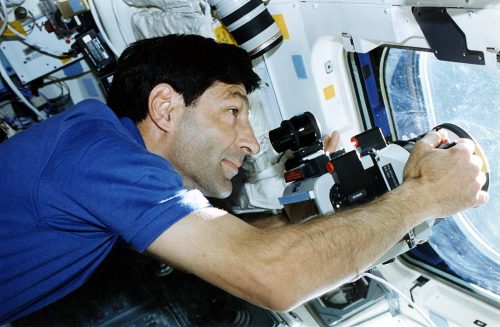
Mounted atop a Hitchhiker structure in Endeavour’s payload bay was the Technology Experiments for Advancing Missions in Space (TEAMS), provided by NASA’s Goddard Space Flight Center (GSFC) of Greenbelt, Md., which featured four investigations: the GPS Attitude and Navigation Experiment (GANE) to gauge the effectiveness of Global Positioning System technology, which was then in its infancy, the Vented Tank Resupply Experiment (VTRE) to evaluate improved methods for refueling in space, the Liquid Metal Thermal Experiment (LMTE) to test potassium-filled liquid metal heat pipes in microgravity, and the Passive Aerodynamically Stabilized Magnetically Damped Satellite-Satellite Test Unit (PAMS-STU).
The latter was of particular interest on STS-77, for its presence led the mission to establish a new record as the first shuttle flight to complete as many as four separate rendezvous operations. Developed by NASA-Goddard, PAMS-STU was a technology demonstrator for the principle of natural “aerodynamic stabilization,” which it was hoped might increase the orbital lifetime of satellites by reducing or eliminating the need for large quantities of attitude-control propellants. “Aerodynamic stabilization works the same way as a dart,” NASA explained shortly before the STS-77 launch. “The front of the dart is weighted and once the dart is thrown, it will always right itself with the head facing forward. In the same manner, the PAMS-STU satellite will eventually be oriented with the heavy end facing forward in orbit. This principle can be used to partially control the attitude of small satellites.”
On the fourth day of the mission, 22 May 1996, the PAMS-STU operations got underway when Runco deployed the cylindrical, 2 x 3 foot (60 x 90 cm) satellite at 5:18 a.m. EDT from a canister at the rear end of Endeavour’s payload bay. As intended, it drifted away from the orbiter in a rotating, unstable attitude, in order to evaluate how quickly and effectively it could stabilize itself using natural aerodynamics. Casper and Brown maneuvered the shuttle to a distance of nine miles (14.6 km) to begin the first of three scheduled rendezvous exercises. A little over 4.5 hours later, they drew closer to about 1,970 feet (600 meters) to track PAMS-STU with the laser-based Attitude Measurement System (AMS) in the payload bay. However, it was noticed that the satellite had not yet stabilized itself and a strong “lock” could not be obtained. With two further rendezvous sessions, each lasting around 6.5 hours, planned for 24 and 25 May, Endeavour withdrew to a maximum distance of about 64 miles (103 km).
During their second rendezvous on 24 May, Casper and Brown reached a station-keeping point just 1,700 feet (520 meters) from PAMS-STU and held their position for more than six hours, until a problem arose with the Space Experiment Facility (SEF) in the Spacehab module and Andy Thomas was called away to commence troubleshooting. It was clear from video imagery acquired by the crew that the satellite had begun to stabilize itself with natural aerodynamic forces, albeit somewhat slower than expected. The third and final rendezvous was postponed by 24 hours, until 26 May, in order for engineers to evaluate the AMS, which provided high-accuracy data on the behavior and relative motions of PAMS-STU. Although it had proven its ability to track the small satellite, the laser system seemed to be locking onto an unknown target (perhaps a structure in the payload bay) and was subjected to intensive troubleshooting.
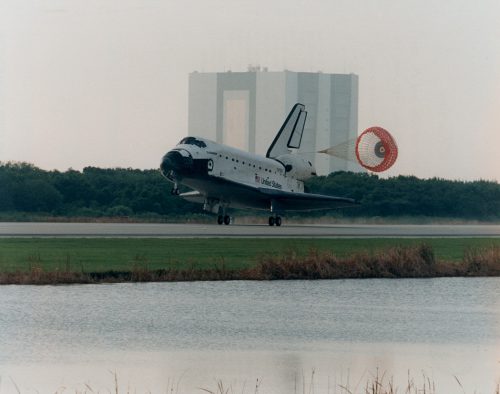
Throughout those 24 hours, Endeavour moved away from the satellite, reaching a maximum distance of about 115 miles (185 km), before Casper executed a Reaction Control System (RCS) thruster firing on the 26th to begin the third period of rendezvous. Closing on PAMS-STU at about 2.3 miles (3.7 km) per orbit, this time the operation ran by the book, with Casper and Brown guiding their ship to within 1,800 feet (550 meters) of their quarry. As the orbiter’s payload bay faced the satellite, NASA-Goddard flight controllers successfully commanded the AMS to calculate its attitude to within one-tenth of a degree. The pilots moved closer, to just 1,640 feet (500 meters), and held their position for seven hours and 45 minutes. This was about 70 minutes longer than planned, as controllers verified that the AMS laser was impinging on PAMS-STU’s reflectors. Throughout the third rendezvous, the satellite remained very stable and validated the aerodynamic stabilization concept.
Departing PAMS-STU for the final time, the STS-77 crew entered the final days of their mission, heading for a landing at the Kennedy Space Center (KSC) in Florida on 29 May 1996. It was expected that the small satellite would re-enter the upper atmosphere to destruction after a few weeks, although trajectory specialists noted that it might remain aloft until as late as January 1997. (As circumstances transpired, PAMS-STU ended its days on 26 October 1996.)
Weather forecasts at KSC and Edwards Air Force Base, Calif., were highly favorable for an on-time landing, with two opportunities available at each site on the 29th. The first opportunity to land in Florida was taken, and Casper executed the de-orbit burn at 6:09 a.m. EDT and guided his ship to a smooth touchdown on Runway 33, precisely an hour later, at 7:09 a.m. With more than 21 cumulative hours of formation flying, Endeavour’s crew had secured a new record for themselves by becoming the first shuttle mission to execute four discrete periods of rendezvous and the longest amount of rendezvous ops. STS-77 also marked the first shuttle flight to be powered into orbit by a full set of three Block I Space Shuttle Main Engines (SSMEs) and the first to be fully controlled from the new Mission Control Center (MCC) at the Johnson Space Center (JSC) in Houston, Texas.
This is part of a series of history articles, which will appear each weekend, barring any major news stories. Next week’s article will focus on the 55th anniversary of President John F. Kennedy’s historic speech to the nation, which committed America to landing a man on the Moon before the end of the 1960s.
Want to keep up-to-date with all things space? Be sure to “Like” AmericaSpace on Facebook and follow us on Twitter: @AmericaSpace




